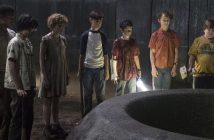
Editor’s Note: The Stranger was released on August 29, 2017 on Blu-ray and DVD by Olive Films.
Orson Welles’ The Stranger (1946) is a tight little film noir that has been unfairly relegated to second-class status for decades. Lightly lurid and with a performance from Welles so broad as to occasionally elicit chuckles, Welles would later tell Cahiers du cinéma that The Stranger was “one of my films of which I am least the author.” Cinephiles followed suit, dismissing the film outright, often because they felt there was so little of Welles himself in it. The movie proved the genius Orson Welles could be “normal,” Welles himself once said, that he “didn’t glow in the dark.” But sometimes the artist is the last person in the world you should ask about the art, and despite generations of dismissals, including Welles’ own, The Stranger is slowly coming to be regarded — rightfully — as a solid and entertaining thriller worthy of its place in the film noir genre.
Investigator Mr. Wilson (Edward G. Robinson) of the War Crimes Commission convinces the government to release former Nazi Konrad Meinike (Konstantin Shayne) in hopes that he will lead them to the notorious Franz Kindler, an escaped Nazi responsible for the creation of an entire network of concentration camps. Meinike does indeed lead Wilson to a small town in Connecticut, but knocks the G-man out before tracking down his old friend. Now posing as local professor Charles Rankin (Orson Welles), a model citizen who is happy to spend his evenings fixing the broken clock in the town square, Kindler still dreams of a day when the Nazis will rise again. Meinike doesn’t share this dream, so Rankin murders him, drags his body into a ditch, then heads back into town to marry the lovely Mary Longstreet (Loretta Young) a few hours later, as one does. Mary, devoted to her husband to the point of hysteria, refuses to believe Wilson when he confronts her with evidence of her husband’s crimes.
Welles suffered a terrible reputation post-Magnificent Ambersons, where a fickle and cranky Hollywood had labeled the former boy genius, not entirely inaccurately, as expensive and impossible to deal with. The studio, International Pictures, was so worried about Welles’ behavior they planned a strict editing schedule in advance of filming that he had to adhere to or risk being fired. Welles agreed, in part because he wanted to show the industry that he could make the kind of commercially successful films that studios wanted.
The Stranger shows fewer of the usual Wellesian touches than any of his other films, while featuring unmistakable influences from other directors like Hitchcock and Capra. Still, there is at least one reference to Orson’s own work here: the use of the bell tower in the center of the tiny town of Harper, Connecticut, an homage to his silent movie Hearts of Age, made when he was still at the Todd School for Boys in 1934. A poster seen briefly in the background mentions Orson’s alma mater as well.
Though the film may not have borrowed much from Welles’ work, he would end up quoting The Stranger (intentionally or not) repeatedly over the next two decades. The checkout area of Mr. Potter’s drugstore shows up again in Touch of Evil; the shadow of the husband looming over the marital bed is seen later in Macbeth; Rankin looks down from on high and comments unkindly upon the little people below just as Harry Lime does in The Third Man.
Barbara Leaming noted in her biography of Welles that he was concerned with persistence of fascism after the war, a concern which may have been one of the reasons he was so willing to do the film despite the forced restraints on his creativity. Further, film scholar Michael Anderegg posits that his Rankin is outrageously and transparently evil not because of Welles’ poor acting choices, but because of a pointed desire to indict small-town American complacency, the “it can’t happen here” laziness that he felt would end up allowing fascism to rise again and again. In one of Welles’ post-war columns in the New York Post written a year before The Stranger and quoted by Jennifer Lynde Barker in the included essay, he argued that fascism begins as “an exaggerated provincialism” that leads to a hatred of strangers and neighbors and, eventually, racism and isolationism.
It’s that suspicion of persons unknown that fuels much of the tension in The Stranger, but it’s suspicion of Mr. Wilson; the town has long since vetted Rankin and, to them, he’s no longer a stranger at all. But their vetting process, seen through a series of amusing moments as Wilson learns how to get his own coffee at the drugstore and lets himself get beaten at checkers by Mr. Potter, is foolish and ineffective, and amounts to little more than the curiosity of the perpetually bored. Rankin could probably sing the Horst-Wessel-Lied right out loud and no one in town would think much of it, because of the false sense of security their exaggerated provincialism gives them.
Like many post-war noir films, The Stranger exists in a world fueled by paranoia and populated with broken men. It’s a world where loyalty and duty, traits that had just gotten us through a horrific world war, were more likely to kill you than save you. Conformity is expected; conformity is safety. Passion is dangerous, almost as dangerous as intellectualism, and you’d better listen to the nice government man if you want to survive.
Olive Films has just released The Stranger on a new Blu-ray that comes with English subtitles, theatrical trailer, booklet, new commentary by Nora Fiore, and essay by Jennifer Lynde Barker.



